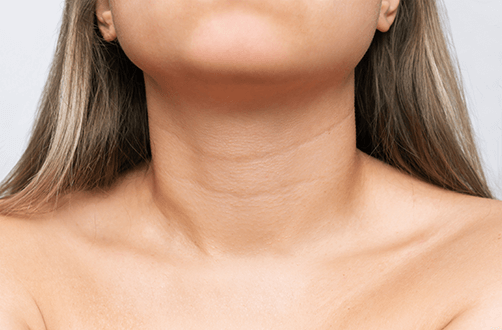Neck Bands Treatment and Prevention Options

Neck bands, also known as platysmal bands, are lines that run across the front of the neck. Although natural aging is the primary cause of neck bands, they can also be prominent in younger patients. They can give the appearance of sagging skin, contributing to the presence of a double chin, neck creases, and what is often referred to as “turkey neck.” Fortunately, there are various treatment options available to address noticeable platysmal bands. Let’s explore the causes of these bands and potential non-surgical and surgical treatment options.
What Are Neck Bands?
As mentioned above, neck bands are lines that run across the front of the neck, either horizontally or vertically.
Horizontal neck bands, also known as necklines or necklace lines, run across the front of the neck. They are typically caused by the natural aging process and can become more prominent over time due to the relative lack of fat in the neck area, as well as factors such as weight loss and prolonged sun exposure without UV protection. Horizontal neck bands can contribute to the appearance of sagging or crepey skin in the neck and may result in a loss of contour underneath the jawline.
Vertical neck bands, on the other hand, refer to two strips of muscle that run vertically down both sides of the neck. These bands are caused by contractions of the platysma muscle, which is the most superficial muscle layer in the face and neck.
While neck bands generally become more apparent as a natural part of aging, genetics and lifestyle can play a role as well. Exercise and muscle activity can also contribute to the appearance of neck bands.

Example of neck lines
Preventing Neck Bands
Although there is no way to prevent the occurrence of neck bands, there are ways to delay the onset as long as possible.
- Avoid unnecessary neck strain, such as when lifting weights
- Try not to engage in activities that require looking down for extended periods of time, such as looking at a phone
- Wear UV protection, whether SPF sunscreen or protective clothing
- Follow a skin care regimen that focuses on anti-aging benefits and antioxidants to protect from damage
Can Doing Neck Exercises Help Minimize Neck Bands?
While neck exercises may help strengthen and tone the muscles in the neck, their effectiveness in minimizing neck bands is somewhat limited.
However, certain exercises that target the muscles in the neck, such as the platysma muscle, may provide some benefits. These exercises can potentially help improve muscle definition and tighten the neck area, which might indirectly contribute to a reduction in the prominence of neck bands. It’s important to note that the results can vary among individuals, and the impact of exercises on neck bands may be modest.
Treatment Options For Early Neck Band Development
There are several non-surgical treatment options available for mild neck bands, including Botox and dermal fillers. The ideal candidate for these treatments are patients who are within a healthy weight range, have little or no fat under their jawline, and whose neck bands would only be considered mild to moderate with minimal grooving,
Botox
When injected into the platysmal bands, Botox works by temporarily relaxing the underlying muscles responsible for the appearance of neck bands. By injecting Botox into specific points along the platysmal bands, the muscle activity is temporarily reduced, resulting in a softer and smoother appearance.
Botox works by blocking the release of a neurotransmitter called acetylcholine, which is responsible for muscle contractions. By inhibiting muscle contractions, Botox can effectively relax the platysma muscle, minimizing the visibility of neck bands.
The treatment itself is relatively quick and involves several small injections along the targeted areas of the platysmal bands. The procedure is typically well-tolerated, and the discomfort is minimal. Results from Botox injections for neck bands can start to become visible within a few days to a week, and they typically last around three to four months.
Dermal fillers
When used for neck bands, dermal fillers are typically applied to restore volume and smooth out the wrinkles and creases caused by sagging skin. The most used dermal fillers are made of hyaluronic acid, a substance naturally found in the body that helps maintain skin hydration and elasticity.
During the procedure, the chosen dermal filler is injected strategically into the areas affected by neck bands. The filler plumps up the skin, effectively filling in the creases and wrinkles associated with the bands. This helps create a smoother, more youthful appearance.
Dermal fillers can also enhance overall skin quality, improve skin texture, and restore lost volume in the neck. By adding volume and promoting hydration, dermal fillers can help tighten the skin and reduce the appearance of neck bands.
The results from dermal filler treatments for neck bands are typically immediate and can last several months to a year, depending on the specific filler used and individual factors. Over time, the body gradually absorbs the filler, and maintenance treatments are often required to sustain the results.
The ideal candidate for Botox or dermal fillers is someone whose necklines are not deep and grooved, is at normal weight, and has little fat underneath the jawline. Some options for those who wish to address fullness under the chin (‘double chin’) are described here and here.
Microdermabrasion, Photofacials, and Fraxel Laser
While not designed to target neck bands specifically, professional treatments like IPL photofacials or Fraxel can indirectly help reduce the appearance of neck bands by exfoliating, resurfacing, color correcting, and stimulating collagen production. The effectiveness of these treatments for neck bands, however, depends on multiple factors such as the severity of the bands and individual skin characteristics. In some cases, a combination of these treatments may yield better results than they would on their own.
Surgical Treatment Options for Prominent Neck Bands
When neck bands or platysmal bands are severe and non-responsive to non-surgical treatments, surgical options may be considered. Here are some surgical procedures commonly used to address severe neck bands:
Platysmaplasty
Platysmaplasty is a surgical procedure that focuses specifically on correcting neck bands. The surgeon makes small incisions under the chin or behind the ears to access and tighten the neck muscles. The platysma muscles are often repositioned or sutured together to create a smoother appearance. Platysmaplasty can be performed as a standalone procedure or in combination with a neck lift for comprehensive neck rejuvenation. Full recovery from a platysmaplasty can range from a few weeks to months, depending on the patient’s individual healing, as well as the extent of the surgery itself.
Lower Facelift
While a lower facelift primarily targets sagging skin, jowls, and wrinkles in the lower face, it can also provide significant improvement in the appearance of neck bands and can be performed during a platysmaplasty for a full facial rejuvenation. During the surgery, the surgeon can access and tighten the platysma muscle. The surgeon may make incisions either in front of or behind the ears and use sutures to tighten and reposition the muscles, reducing the visibility of the bands. Skin is trimmed or lifted, and the remaining skin is repositioned for a smoother and more youthful appearance. Full recovery from a lower facelift can range from a few weeks to months, depending on the patient’s individual healing, as well as the extent of the surgery itself.
Conclusion
Whether opting for non-surgical or surgical option, it is important to have realistic expectations and to follow pre- and post-treatment instructions carefully. Ultimately, the choice between non-surgical and surgical treatments depends on factors such as the severity of the neck bands, individual preferences, and the advice of a qualified professional. With the advancements in cosmetic procedures, both non-surgical and surgical treatments can provide effective solutions to address neck bands and help you achieve a smoother, firmer, and more youthful-looking neck.
